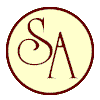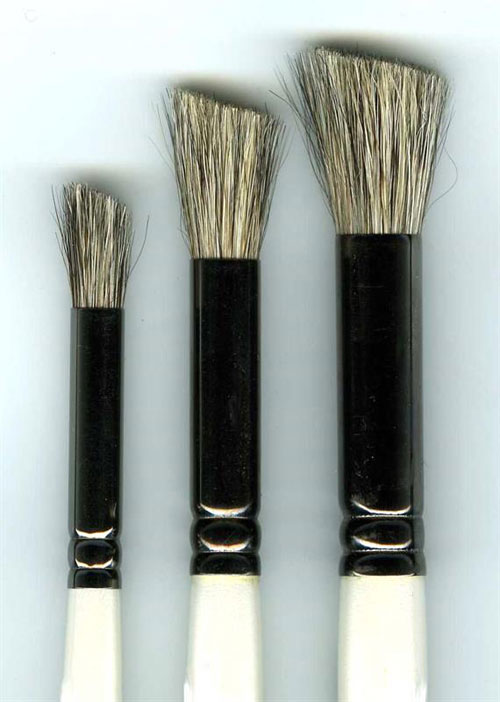|
reproduced with kind permission from
with various additions from other artists DA VINCI http://www.gdfa.net/ .HOW TO CLEAN AND TO LOOK AFTER BRUSHES
The most important thing is to obey the following fundamental rules:
1. Water-soluble colours should be washed out with water.
2.
Acrylic colour, as long as it is wet, should be washed out with water; when dried up it can only be dissolved with special cleaning agents.
3.
Oil colours should be wiped off thoroughly with a piece of cloth. Afterwards the hair of bristles should be cleaned with pure soap (order No. 4033) and warm water until the soap begins to produce white lather. Do not use strongly fat removing soaps or detergents!
4. To wash out the brush rub the body of the
brush carefully and remove the remains of pigment that chiefly stick to the edge of the ferrule.
5. Afterwards wipe the brush with a fine piece of cloth and bring it to its original shape. Artists call this procedure "dressing".
6. Let the brush dry completely before you use it again. Don't put it on the radiator to dry. There the hair will dry too quickly, the handle will shrink, and the brush head will come loose.
Brushes that have not been cleaned properly will lose their interlocking quality after short use, i.e. the hair will stand apart. Moreover, the hair and bristles may break at the edge of the ferrule.
Brushes are often protected during transport by little plastic tubes that keep off the dust until the brush has found its owner.
It has been noticed that time and again these tubes are taken off and then put on again in a less than careful manner, with some of the hair being bent in the process. The damage done can be easily repaired. Put the brush in water and rub it carefully out towards the tip. After the drying which, depending on the brush size, may take between one and five hours, the plastic tube can be placed again over a completely intact brush.
If you put on the plastic tube when the brush is still wet, it will develop mould and smell bad. But that isn't a disaster either. Clean the brush thoroughly in mild soapy water, rub it out to its original shape and let it dry completely this time,
Another important thing to remember when using a brush - squirrel and red sable are too fine for rough surfaces of raw ceramics and stoneware.
It isn't good for a brush to be used alternately with water colour and
acrylic colour or even
Oil colour.
Dipping your brush into washing up liquid before using masking fluid makes
it much easier to clean off.
extra - Save old phone books to wipe brushes on the top
page; discard, and there's a fresh page ready
Old T shirts , off castes clothing - dusting rags TECHNICAL TERMS AND WHAT THEY MEAN
'bound' - round hair brushes of expensive quality standard: Water colour brushes, oil colour brushes and filbert-shaped brushes are pre-formed in a brass tube, then bound and afterwards cupped to characteristic shape with the hand through twisting. A brush is never shaped with a knife or a pair of scissors.
'brown sable' - tails together with the body fur were dyed by the furrier. Brown sable is used for inexpensive sable qualities.
'camel hair' - hair from the pastern of Japanese and other Asian ponies. Why then 'camel' hair? We don't know.
'cementing' - using adhesive to make the hair stick together and to the ferrule. The adhesive used is resistant to all known solvents
'Chungking' - term applied to a white and especially strong Chinese bristle; bristles named after the Chinese city of Chungking
'ferrule' - metal tube that shapes the head of the brush and connects it with the handle. It is either round or flat
'seamless ferrules' - tapered, cylindrical brass tubes, usually plated with nickel or
gold, or made of polished aluminium.
'seamed ferrules' - tin and nickel ferrules have a soldered seam. They are used for some 'budget' quality brushes. When the brush is left in the water too long, the handle will swell and soldered ferrules may break
'Fitch hair' - a name that refers to both the hair of European and Asiatic polecats and to black ox ear hair. These hairs are so short and so smooth, that it is sometimes difficult even for experienced brush-makers not to let these hair slip from their grasp
'flags of bristles' - while it grows the bristle splits into two or more tips, the 'flags'. This fullness of the bristle accounts for the ability to hold a large amount of colour.
'gumming' - the hair and bristles of the finished brush must be protected for transport. We use a gum Arabic solution for that purpose.
'handle' - most of the handles produced are made of wood. Artists often prefer unlacquered, so-called plain wood handles.
Also make a distinction between the lacquered handle and the polished handle.
'Hexagonal handles' - a da Vinci patented design. This handle shows at its thickest part six imperceptible flattenings which are styled in a way that they do not make the hand tired during painting nor impede the turning or shaping of the brush-tip (sizes up to 6 have only 3 flattenings due to the smaller diameter of the handles)
'interlocking' - two equal-sized portions of bristle are set against each other with the natural curve of the bristle turned inward. MAESTRO artists brushes of interlocked construction are labour-intensive; however, they will keep their form even after long and intensive use. Our second quality artists bristle brushes are prepared to interlock, that means that the brush is made from straight bristles and is shaped by heat after gumming. This technique has also proven to be long-lasting and reliable.
'Kazan squirrel' - the name is derived from the Russian town of Kazan. It refers to a species of squirrel whose hair-tips are of brownish-red colour while the remaining part of the hair is flecked with grey. Kazan squirrel hair is manufactured into china painting brushes.
Tip from an Artist using squirrel brushes - "The secret to using
squirrel brushes is soaking them in water for 15 to 30 minutes, laying
flat" . 'Kolinsky' - the tail of the sable "mustela sibirica" (common names are Siberian marten, weasel, polecat - the term sable seems to be confined to the art world). HARBIN-KOLINSKY, named after the capital of the northernmost part of Manchuria. The principal habitat of this "mustela" is the river valley of the Ussuri, the Siberian border river to Manchuria. The tail of this Kolinsky sable is slightly smaller than that of its Russian neighbour, but the hair is very strong, straight and has a fine tip.
TOBOLSKY-KOLINSKY and USSURI-KOLINSKY, named after the most eastern rivers of Siberia. The "mustela sibirica" lives in the basins of the Ob, Lena, Amur and Ussuri rivers. The colonies of these animals are under permanent supervision by the authorities due to their habit of digging into the embankments. The male "mustela sibirica" has an extraordinarily beautiful, bushy tail. From this hair the da Vinci MAESTRO water-colour brush is made.
The decisive point is that this hair is taken from male winter tails. Hair of other species of marten such as the Asiatic weasel or the hair of the female animals which is also of golden-red colour, but not as fine and as springy, is traded on the world market at about half the price. The brush-making industry has traditionally manufactured all of them under the collective term "red sable hair".
'original shape' - the hair of bristles of the brush are brought into their characteristic shape, shape', which
is called "original shape", with the help of a gum arabic solution
'sabeline' - produced from white ox ear hair through dyeing. White ox ear hair is exclusively taken from Alpine cattle. These cattle have particularly strong hair because of the climatic conditions in that region.
ABOUT HAIR, BRISTLES AND SYNTHETIC FIBRES A brush is as good as its hair, its bristles and, nowadays you may also say, its synthetic fibres. How good a brush is, depends on how carefully the raw materials have been selected and manufactured for their respective tasks.
Handling hog bristles and preparing hair from various animal tails, furs and ox ear, are operations in which the experience of generations is involved. Quality features and the proper use of technical terms may also cause difficulties. As previously stated, the most expensive and most valuable soft brush hair, for example, is from the tail of "mustela sibirica", a quality marten which lives in the valleys of the Siberian rivers Amur, Tobol and Ussuri. In the technical language of brush-making it is called "Tobolsky" or "Kolinsky" red sable. The decisive point is that this hair is taken from male winter tails. Hair of other species of marten such as the Asiatic weasel or the hair of the female animals which is also of golden-red colour, but not as fine and as springy, is traded on the world market at about half the price. The brush-making industry has traditionally manufactured all of them under the collective term "red sable hair".
Unfortunately the purity regulations are abused more and more. Often the quality term "Kolinsky" is also used freely when simple red sable hair has been taken. You can be sure with da Vinci Kolinsky red sable,
Winsor& Newton and Pro Arte brushes that the name keeps its promise.
Hairs and bristles are similar in their structure. They consist of a central medulla around which scales are grouped like a shell. The elasticity and the "interlocking quality" of a brush depend on the nature of these scales. If you leave a brush in the water too long or if it cannot dry properly, this shell of scales opens up like a fir-cone. You feel that it has lost some of its spring and colour holding capacity. After thorough cleaning with pure soap and intensive drying, the brush has been brought back onto its original shape. The scales close tight onto the medulla, the hair and bristles have regained their original spring and the brush is a perfect tool again.
However, natural hair gets more precious by the year and it is necessary to accept the challenge to our generation to protect and preserve natural species and resources, resulting in intensive research into synthetic fibres.
| 



